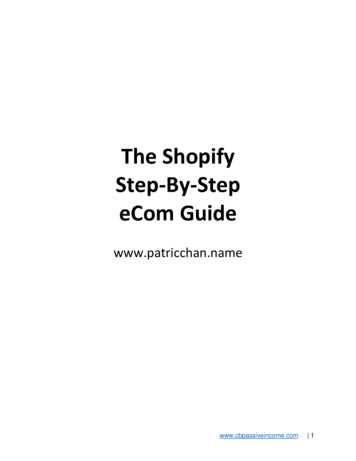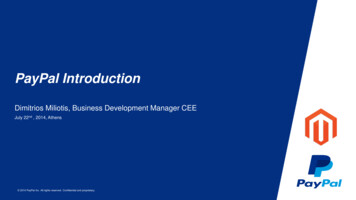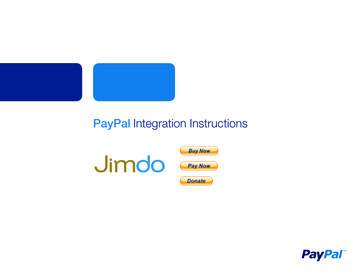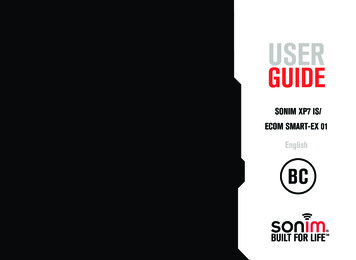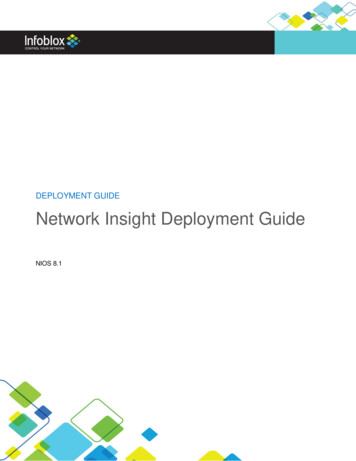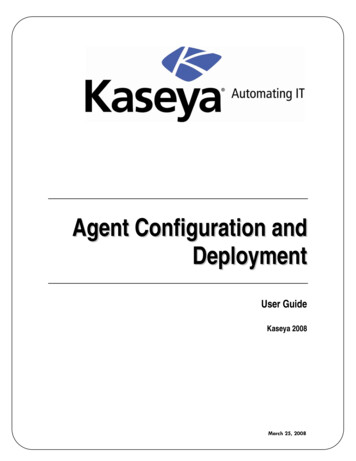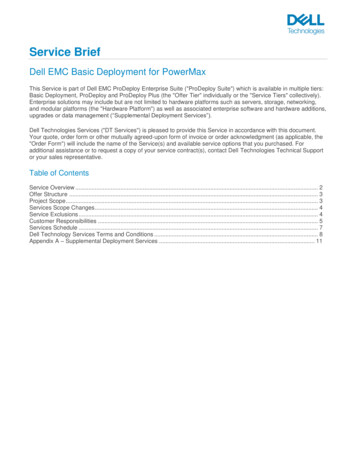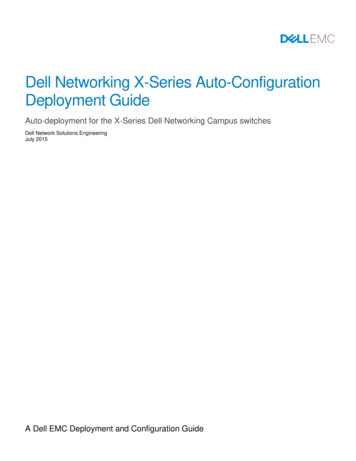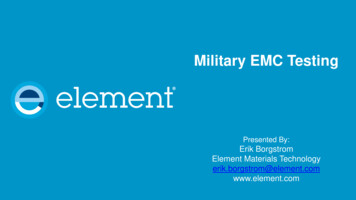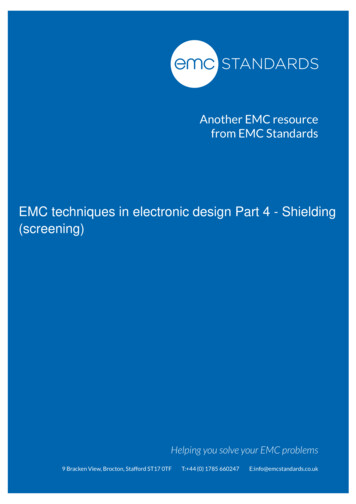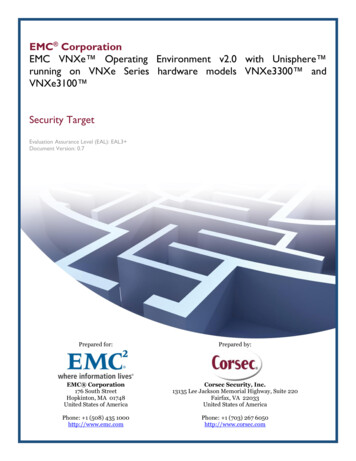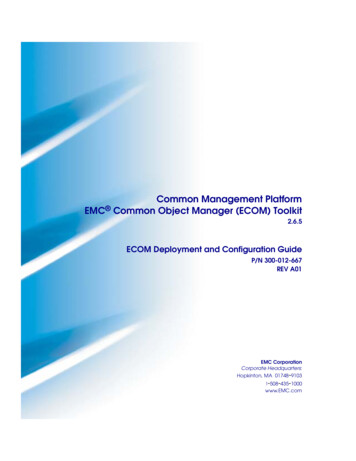
Transcription
ECOM.book Page 1 Sunday, May 22, 2011 1:31 PMCommon Management PlatformEMC Common Object Manager (ECOM) Toolkit2.6.5ECOM Deployment and Configuration GuideP/N 300-012-667REV A01EMC CorporationCorporate Headquarters:Hopkinton, MA 01748-91031-508-435-1000www.EMC.com
ECOM.book Page 2 Sunday, May 22, 2011 1:31 PMCopyright 2011 EMC Corporation. All rights reserved.Published June, 2001EMC believes the information in this publication is accurate as of its publication date. The information issubject to change without notice.THE INFORMATION IN THIS PUBLICATION IS PROVIDED “AS IS.” EMC CORPORATION MAKES NOREPRESENTATIONS OR WARRANTIES OF ANY KIND WITH RESPECT TO THE INFORMATION IN THISPUBLICATION, AND SPECIFICALLY DISCLAIMS IMPLIED WARRANTIES OF MERCHANTABILITY ORFITNESS FOR A PARTICULAR PURPOSE.Use, copying, and distribution of any EMC software described in this publication requires an applicablesoftware license.For the most up-to-date listing of EMC product names, see EMC Corporation Trademarks on EMC.com.All other trademarks used herein are the property of their respective owners.2ECOM Deployment and Configuration Guide
ECOM.book Page 3 Sunday, May 22, 2011 1:31 PMContentsPreface. 5Chapter 1Overview of CIM and SMI-SModeling with CIM and SMI-S.Structural model overview.Profiles.MOF .Interoperability with CIM.WBEM .SLP .CIM intrinsic and extrinsic operations .SMI-S Server (CIMOM) profile .CQL.Additional information for modeling .ECOM supported standards matrix.Chapter 2101011121313141617181920Running ECOMStarting and stopping ECOM.Starting ECOM .Accessing the ECOM Administration Web Server .Stopping ECOM.Checking the installed version of ECOM.Running ECOM under a debugger.Reviewing ECOM log files .Testing ECOM deployments .Checking ECOM response.Checking SMI-S compliance .Obtaining further information about ECOM.ECOM Deployment and Configuration Guide24242628282931353535363
ECOM.book Page 4 Sunday, May 22, 2011 1:31 PMContentsChapter 3ECOM Communication SecurityECOM port security . 38I.P. filtering. 41Securing ECOM communication. 43Appendix ASLP ConfigurationOverview .Requirements .Configuration .Testing response.Appendix BECOM Server Profile ProviderOverview .Requirements .Configuration .Testing response.Appendix C60626262ECOM Repository ProviderOverview .Requirements .Configuration .Testing response.Appendix E56565658ECOM Indication Subscription ProviderOverview .Requirements .Configuration .Testing response.Appendix D4848525464646465CQL SupportSupported CQL. 68Known limitations. 69Appendix FCIM Indication SupportConfiguring indications support.Managing indication subscriptions .Secure indication delivery.Known limitations.4ECOM Deployment and Configuration Guide72738080
ECOM.book Page 5 Sunday, May 22, 2011 1:31 PMPrefaceThe EMC Common Object Manager (ECOM) is a hub of communicationsand common services for applications based on EMC’s CommonManagement Platform. This document contains an overview of ECOM,instructions for its deployment and configuration, basic use cases forECOM, and other related reference material.As part of an effort to improve and enhance the performance and capabilitiesof its product lines, EMC periodically releases revisions of its hardware andsoftware. Therefore, some functions described in this document may not besupported by all versions of the software or hardware currently in use. Forthe most up-to-date information on product features, refer to your productrelease notes.AudienceThis document is part of the Common Management Platformdocumentation set, and it is intended for use by EMC developersseeking to create and deploy management applications that rely onECOM for resource exposure.Readers of this document are expected to be familiar with thefollowing topics: Common Information Model (CIM)Web-Based Enterprise Management (WBEM)Storage Management Initiative - Specification (SMI-S)Service Location Protocol (SLP)IP Multicast.ECOM Deployment and Configuration Guide5
ECOM.book Page 6 Sunday, May 22, 2011 1:31 PMPrefaceConventions used inthis documentEMC uses the following conventions for special notices.Note: A note presents information that is important, but not hazard-related.!CAUTIONA caution contains information essential to avoid data loss ordamage to the system or equipment.!IMPORTANTAn important notice contains information essential to operation ofthe software.WARNINGA warning contains information essential to avoid a hazard that cancause severe personal injury, death, or substantial property damageif you ignore the warning.DANGERA danger notice contains information essential to avoid a hazardthat will cause severe personal injury, death, or substantial propertydamage if you ignore the message.Typographical conventionsEMC uses the following type style conventions in this document:6NormalUsed in running (nonprocedural) text for: Names of interface elements (such as names of windows,dialog boxes, buttons, fields, and menus) Names of resources, attributes, pools, Boolean expressions,buttons, DQL statements, keywords, clauses, environmentvariables, filenames, functions, utilities URLs, pathnames, filenames, directory names, computernames, links, groups, service keys, file systems, notificationsBold:Used in running (nonprocedural) text for: Names of commands, daemons, options, programs,processes, services, applications, utilities, kernels,notifications, system call, man pagesECOM Deployment and Configuration Guide
ECOM.book Page 7 Sunday, May 22, 2011 1:31 PMPrefaceUsed in procedures for: Names of interface elements (such as names of windows,dialog boxes, buttons, fields, and menus) What user specifically selects, clicks, presses, or typesItalic:Used in all text (including procedures) for: Full titles of publications referenced in text Emphasis (for example a new term) VariablesCourier:Used for: System output, such as an error message or script URLs, complete paths, filenames, prompts, and syntax whenshown outside of running textCourier bold:Used for: Specific user input (such as commands)Courier italic:Used in procedures for: Variables on command line User input variables Angle brackets enclose parameter or variable values supplied bythe user[]Square brackets enclose optional values Vertical bar indicates alternate selections - the bar means “or”{}Braces indicate content that you must specify (that is, x or y or z).Ellipses indicate nonessential information omitted from theexampleWhere to get helpSupport, downloads, and licensing information can be obtained asfollows.Product information — For documentation, release notes, softwareupdates, or for information about this and other products andservices, go to:http://cmpdistributions.eng.emc.comTechnical support — For technical support, go to the forums:http://cmgportal.lss.emc.com/forum/ECOM Deployment and Configuration Guide7
ECOM.book Page 8 Sunday, May 22, 2011 1:31 PMPrefaceYour commentsYour suggestions will help us continue to improve the accuracy,organization, and overall quality of the user publications. Please sendyour opinion of this document to:scribes-CMG@emc.com8ECOM Deployment and Configuration Guide
ECOM.book Page 9 Sunday, May 22, 2011 1:31 PM1Overview of CIM andSMI-SInteroperability within an heterogeneous environment can beachieved by ensuring that management applications and serviceproviders hold the same conceptual view of resources within theirdomain. ECOM supports the EMC Common Information Model(ECIM), which uses an enterprise wide set of models of specificresource and information elements to represent the variedcomponents found within today's diverse IT environments. ECIM isbased on the industry-standard Common Information Model (CIM)and also incorporates SMI-S in addition to EMC-specific models andprofiles. A knowledge of CIM and SMI-S is therefore necessary tounderstand the framework within which management applicationsand service providers interoperate using ECOM. Within this book, aservice provider is defined as a managed element that exposes data orfunctionality to clients on a network for consumption by other serviceproviders or by management applications, which are both grouped into the category service client or consumer.The following sections provide a basic overview of CIM, SMI-S, andthe communication protocols needed to support the model-drivenframework of the Common Management Platform, including ECOM. Modeling with CIM and SMI-S.Interoperability with CIM.Additional information for modeling .ECOM supported standards matrix.Overview of CIM and SMI-S101319209
ECOM.book Page 10 Sunday, May 22, 2011 1:31 PMOverview of CIM and SMI-SModeling with CIM and SMI-SThis section provides a brief overview of the structure, use, andrepresentation of CIM-based models.Structural modeloverviewThe CIM schema provides a common methodology for representingsystems, networks, applications, and services as a set ofobject-oriented models that can be bound to real-world data andfunctionality. Management applications based on CIM can interactwith heterogeneous resource instances, such as data storagehardware from multiple vendors, without direct knowledge of theunderlying system interfaces.CIM defines several basic model structures for IT resources.ClassesCIM classes identify types of resources. A class can represent a broadcategory of resources or can be subclassed to represent a specific type.For example, the class CIM NetworkPort represents a broad categoryof heterogeneous network communications hardware, whileEMC NetworkPort is a subclass that represents an EMC-specificsubset.While classes define types of things found in a managed ITenvironment, instances represent individual implementations of aclass. A specific port at a specific network address is an example of aninstance of class EMC NetworkPort. Classes define the state, behavior,and identity information (called properties) that distinguishes eachinstance. CIM also defines the operations that can be performed byinstances of a class (called methods), linking models to system-specificfunctionality.10QualifiersMany elements in CIM can be further specialized through the use ofqualifiers. Qualifiers enhance or apply constraints to associations,classes, indications, methods, method parameters, properties andreferences by providing additional information that distinguishesthem from similar elements and/or their superclasses. For example,qualifiers can be used to make a class property vendor-specific bydefining minimum and maximum values for it. as appropriate for thevendor’s modeled resource.AssociationsAn association, which is a class with the association qualifier, defines arelationship between two or more classes. An association containstwo or more references that define the classes linked by theECOM Deployment and Configuration Guide
ECOM.book Page 11 Sunday, May 22, 2011 1:31 PMOverview of CIM and SMI-Sassociation. However, because an association is its own separateclass, it does not impact the associated classes themselves. Forexample, an association could link the classes representing the virtualmachines defined on a server to the class of the server itself.IndicationsProfilesAn indication, which is a class with the Indication qualifier, defines anevent of interest that might occur in a managed environment.Instances of Indications are transient objects and cannot be queriedusing standard CIM Intrinsics. Rather, to receive indications, anapplication must create a subscription to an indication class to receivenotification of its instances. Indications can be divided into twocategories. Life-cycle indications are notifications related to thecreation, deletion, and modification of objects modeled in CIM.Process indications are notifications of events that may not becompletely modeled by CIM. Direct feedback from instrumenteddevices or SNMP traps are examples of process indications.Subscribers to indications can define filters that further limit theindications they are notified of.Because CIM contains almost 2000 classes and is meant to have broadapplicability to managed IT environments, some industry groupshaven chosen to create profiles that address the usage of CIM inspecific domains. To promote device and application interoperability,profiles unambiguously define sets of classes, associations,indications, methods, properties that must be used to model themanaged resources of the domain. In addition, profiles also specifyrequired property values, required interconnections for associations,and certain method behaviors that are not typically encoded intoMOF files. Profiles also define other requirements that cannot berepresented in MOF, such as the use of a specific communicationprotocol by devices adhering to the profile. Profiles generally includerecipes that serve as examples to guide server-side implementers andclient-side application writers in proper usage of the profile.Compliance with specific profiles ensures that managed resourcesand management applications share the same conceptual view oftheir environment and of each other. SMI-S is a good example ofprofiles applied to a storage-related domain.SMI-SThe Storage Management Initiative - Specification (SMI-S) publishedby the Storage Networking Industry Association (SNIA) providesseveral examples of profiles that are used to enable theinteroperability of heterogeneous storage and storage-relatedModeling with CIM and SMI-S11
ECOM.book Page 12 Sunday, May 22, 2011 1:31 PMOverview of CIM and SMI-Sresources within a network. SMI-S includes domain profiles andsubprofiles for arrays, switches, storage virtualization, volumemanagement, and many other storage-related resources andconcepts. Additionally, SMI-S defines: the communications protocol (CIM-XML) used to exchange CIMmodels via XML (xmlCIM) over HTTP(S) the protocol used to discover available services, which is calledthe Service Location Protocol (SLP) version 2ECOM complies with SMI-S version 1.2, including compliance withthe following standards:MOF CIM schema version 2.14 CIM/XML version 2.2 CIM/XML over HTTP version 1.2 Service Location Protocol (SLP) version 2 SSL 3.0 / TLS 1.0The Managed Object Format (MOF) is a way to represent CIMmodels in text form. Within a MOF file, the classes, associations,properties, references, methods and associated qualifiers are definedfor a domain to be modeled. MOF files are often the starting point fordevelopers seeking to create providers that expose modeled data andfunctionality through ECOM. MOF files can used by tools such as theOSL# MOF Compiler to generate C header and source files thatrepresent the objects modeled in the MOF file. These generated filesform the basis for the resource exposure plug-in that links ECOM toresource-specific functionality.[ EMC Sample2IsLeaf,EMC CtorArgTypes{ "const char *", "const char *" },EMC CtorArgNames{ "arrayId","volumeId"},Description( "Sample storage volume" ) ]class SP StorageVolume : EMC StorageVolume{};Figure 112MOF file entry for class SP StorageVolumeECOM Deployment and Configuration Guide
ECOM.book Page 13 Sunday, May 22, 2011 1:31 PMOverview of CIM and SMI-SInteroperability with CIMThe consistent modeling of domain resources is only the first step increating a network of interoperable management applications andmanaged resources. The abilities to exchange model information, toretrieve data from and execute commands through models, and todiscover available resources are also required to link theheterogeneous elements in a network. The following sectionsdescribe the communication and discovery requirements of SMI-S1.2. These requirements are fully supported by ECOM.WBEMWeb-Based Enterprise Management (WBEM) is a group of Web-basedtechnology standards advocated by the Distributed ManagementTask Force (DMTF) to facilitate unified management of enterprise ITenvironments. WBEM incorporates: a model (CIM) to represent resources an XML-based communication protocol (CIM-XML over HTTP)to facilitate interaction between network components1 an XML representation of CIM models and messages (xmlCIM) totravel via CIM-XML a discovery protocol (SLP) to allow management applications todiscover available servicesThe combination of WBEM technologies allows ECOM to serve as theinteroperability hub of the Common Management Platform (CMP).1. WS-Management is also advocated by the DMTF as analternative to CIM-XML.Interoperability with CIM13
ECOM.book Page 14 Sunday, May 22, 2011 1:31 PMOverview of CIM and SMI-SFigure 2SLPIn this very simple
EMC Corporation Corporate Headquarters: Hopkinton, MA 01748-9103 1-508-435-1000 www.EMC.com Common Management Platform EMC Common Object Manager (ECOM) Toolkit 2.6.5 ECOM Deployment and Configuration Guide
